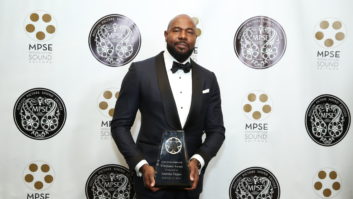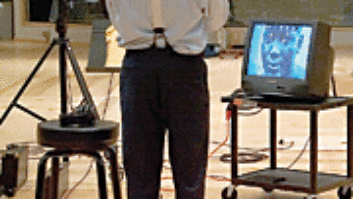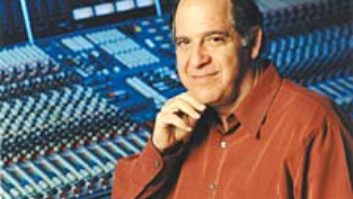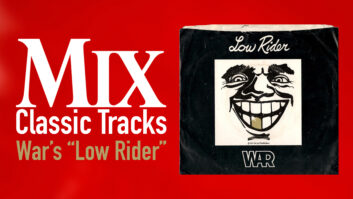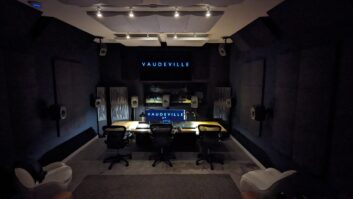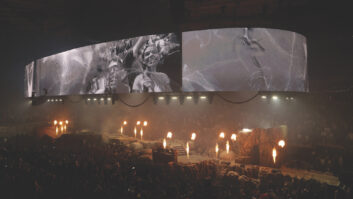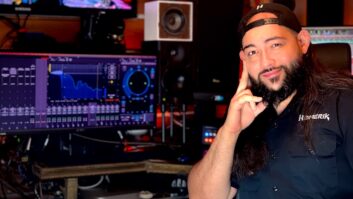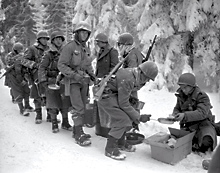

During World War II, while the rest of the world followed the conflict through theatrical black-and-white newsreels with patriotic music and narration, soldiers on the field saw the action from an entirely different angle. It is the soldiers’ grim reality that documentary filmmaker Ken Burns has captured in his new PBS mini-series, The War, which premieres September 23.
Bringing the soldiers’ experiences home, including this scene in Belgium, circa January 1945
Photo: National Archives
Having worked on the series for the past six years, Burns notes, “World War II has been smothered with gallant, bloodless myths, and when we do that we do ourselves a disservice.” The series focuses on the lives of servicemen from four American towns, revealing not only the experiences the soldiers has in the battlefield, but also the effects the war had on those back home. “If you weren’t in this war or you weren’t waiting anxiously for someone you loved to come home, you’re not in this film,” Burns says.
Burns portrays the experiences of the soldiers as realistically as possible. Researchers at his Walpole, N.H., production office dug up pristine camera negatives of hours and hours of war coverage. But the most striking thing about the film is its soundtrack, which portrays in full surround — with lethal authenticity — the experience of the soldier in the field.
“Bullets whiz by your head, planes fly overhead and you turn your neck around,” describes Burns. “And the debris from explosions seems to fall in your living room, at your feet. And that’s the way we want it — to put you uncomfortably into the battle.” The film is only Burns’ second project to be mixed in 5.1; the first was the 2004 Unforgivable Blackness: The Rise and Fall of Jack Johnson about America’s first African-American heavyweight boxing champ.

Documentary filmmaker Ken Burns
Photo: Cable Risdon, 2002
To achieve the sound image he wanted for The War, Burns turned to a number of familiar collaborators: sound effects editors Erik Ewers and Ira Spiegel, and re-recording mixer Dominick Tavella. Ewers, who was also picture editor for three of the seven episodes, has worked with Burns since Empire of the Air (1991), Spiegel since the seminal The Civil War (1990) and Tavella since Baseball (1994). “Ken’s essentially been using the same crew for years and years,” says Tavella. “We have a real history, a shorthand of how things are to go down.”
Sound effects editing for the series was split between two teams: Ewers, along with his co-editor Ryan Gifford (who also assisted in picture editing) and dialog editor Magdalena Violotus worked on episodes 2, 3 and 6 at the Florentine Films offices in New Hampshire. Spiegel worked with sound effects editor Mariusz Glabinski and dialog editor Marlena Grzaslewicz (who worked on Baseball) in various locations, including home studios and 701 Sound in New York’s Brill Building. Spiegel, Glabinski and Grzaslewicz worked on the remaining four episodes, which were picture edited by Paul Barnes and Tricia Reidy. Picture editing began in the fall of 2004, and sound effects work was done in winter/spring 2006. The teams were given five weeks per episode to complete their work.
First, spotting sessions were held with Burns, Ewers and Spiegel, along with co-director Lynn Novick, producer Sarah Botstein and supervising film editor Paul Barnes. “We’d watch through an entire episode, with everyone expressing their ideas,” says Spiegel. “Ken has strong ideas about what he wants, but he’s trusting and respectful of other people’s ideas.”
It was imperative that the two separate groups maintained consistency in their effects and preserved smooth workflow from editing to mixing. Ewers and Spiegel would stay in contact, when possible, to compare notes on various sounds. “One of us might ask, ‘Okay, what are you using for a grenade?’ or something like that,” explains Ewers. “Due to the schedule, we didn’t have a lot of time to talk — we just hoped that we’d come to the same conclusions. And I think you’ll hear very little difference between his effects and mine.”
The two teams also shared extensive effects libraries. While none of the sound effects heard were field-recorded specifically for the film, Florentine acquired massive libraries from previous films that had included original field-recorded sounds. Actor Tom Hanks not only provided the voice-over for journalist Al MacIntyre, but also the effects library from his acclaimed Band of Brothers HBO series. “We got a full drive of effects, probably 200 to 300 explosions, at least 200 different kinds of weapons. We were quite fortunate,” says Ewers.
Also used were the effects from Korean film Tae Duk Gi (2004), as well as a British archive that had recordings of the Mitsubishi engines in Japanese Zero airplanes — particularly useful in the first episode that depicts the attack on Pearl Harbor.
The remainder came from conventional sources, such as Sound Ideas, though these had to be used with care. “The trouble with [those sounds] is that they often sound too modern,” Spiegel says. “They have automatic weapons or Abram 1 M1A tanks, which are too modern. That’s why we went to Band of Brothers for the authenticity.”

Re-recording mixer Dominick Tavella at his home base: Sound One’s Neve DFC Gemini
Authenticity was indeed the name of the game for The War. “When you see a German 88 [gun], you hear a German 88. When you see a Tiger Tank, you hear a Tiger Tank,” says Spiegel. Adds Burns, “Even a Panzer tank in snow, a Panzer tank on wet road, a Panzer tank on dry road.” The correct guns, correct arms, even correct airplane engines — lest a Japanese Zero sound like a P-41 Mustang.
During the mix, Tavella took care to ensure that Pacific battles sounded different from European battles. “It’s very easy when you’ve got a ton of bombs and guns going off to make it too dense so it all sounds the same,” he says. “Pacific battles were hitting islands, so the bombardment was from destroyers and battleships rather than long-range artillery. And Pacific battles weren’t all-out assaults, but more sporadic firefights and skirmishes. The European battles tended to be all-out assaults.”
Sometimes, if no library recording existed for a particular piece of armament, a sound needed to be created. “We discovered very early on that there are not very good recordings of German 88s,” says Spiegel of the gun that could shoot down American planes and knock out tanks. “We had some recordings on an old German optical archive track. They were good as a reference, but they didn’t convey the fright of the gun, and they had crackle on them and were recorded from very far away.”
So he and Glabinski built the sound from scratch. “We used three or four very powerful Howitzer artillery sounds, slowing them down to give them more body and weight. And I added a growl from a crocodile, which we synchronized with the recoil of the gun. So at the precise moment it fires, the barrel starts to recoil, and we synchronize the kind of metallic growl with that.”
“We tried our best to stick to the archival sounds,” adds Ewers. “But, of course, sound editors like to use sweeteners to make them a little scarier or a little more vibrant.”
“Creative license trumps everything,” adds Burns. “We’re trying to wake up the past. If we’re a few hundred yards away from a gun going off, we want to have that sound. If it’s up close, we want to hear what the sound of a shell leaving the breach sounds like and the sound of the breach closing. And that recoil, and the sound of the artillery piece digging into the mud. All of these things create the verisimilitude that a veteran is going to respond to, and say, ‘Yes, that’s the way it was.’”
Most significant were the battle scenes, which made full use of Tavella’s 5.1 mix. For Ewers, designing such scenes was helped by the fact that he had picture-edited his episodes. “I would actually start to work my picture around the sound to make a scene even more chaotic and more scary,” he says. “We worked on the design two years before we even got to sound editing, so we were ahead of the game by that point.”

Sound effects editor Eric Ewers
Ewers and Gifford took particular delight in creating such incredible sound paintings. “Erik has a boy’s affinity for this stuff,” notes Burns. “Despite all the horror of war, it’s also ‘cool’ at one level, with all the equipment and stuff. I just let Erik have free reign in just making all of that come alive.”
Spiegel and Ewers would deliver the episodes as 48-track Pro Tools files, using a track layout pre-specified by Tavella. “I wanted to be able to bounce back and forth from show to show as easily as possible. So it was important to get everybody on the same page so that the layouts of their Pro Tools would be exactly the same,” he says.
Tavella worked at his home base in New York’s Sound One, working in Studio A. The room is outfitted with an AMS Neve DFC Gemini digital mixing console. And though it has a large theatrical screen with speakers behind, Tavella opted to view the film on a 42-inch plasma screen, listening through high-quality, near-field JVC powered monitors. “We set it up like a very high-quality home theater since the film wasn’t intended for theatrical release.”
In addition, after mixing the first episode, the engineer had a DVD copy made containing both his 5.1 and stereo broadcast mixes, which he brought home to give them a spin. “I checked it out on about six or eight different systems — everything from my own high-quality 5.1 home theater all the way to a little 11-inch mono TV. I could hear where we were going right and where we were deficient. So we knew that subsequent episodes would play well just about anywhere.”
The complete mixing system included two Pro Tools rigs — one to play back dialog and music, and the other for effects. These were passed through the DFC and out to four Akai DD8 random-access digital film dubber recorders — three for dialog, music and effects, whose outputs were then fed back into the DFC, and a fourth to record the final master. Tavella took full advantage of the Neve’s “layering” capabilities. “These were very, very complicated and dense mixes. And since Ken’s review time was limited, I had to come up with a desk design that would let me step back from the finished product and make any correction Ken wanted at the press of a button.”
The typical process for mixing an episode involved mixing in three passes. In the first pass, which took typically two-and-a-half to three days, Tavella mixed the dialog and music, each to its own stem. The music included source material selected by the producers and editors, as well as new score recordings by jazz composer/performer Wynton Marsalis; his tracks were recorded at New York’s former Right Track Studio (now part of Legacy Studios) in two sessions by engineer James Nichols and produced by the composer’s brother, Delfeayo Marsalis.
Music editing was handled by Jacob Ribicoff, who made the jump from effects editing to music editing on Burns’ Jazz. The majority of the music was placed by the picture editors. “We do music differently from anybody else,” notes Burns. “We get it in advance so that the music becomes an organic and authentic part of our editing process.”
The editors would place the tracks roughly in the correct area, leaving it to Ribicoff to fine-tune-edit the music to make specific onscreen “hits,” as needed, using Serato Pitch ‘n Time. “It typically involves time compression or expansion of a certain section of music,” Ribicoff explains, “slowing it down or speeding it up to catch a particular hit,” such as a cymbal crash to match an onscreen explosion.
Once the music and dialog mixes were set, a second pass was made to mix the effects, for which a third stem was created, after which a third pass was made to create the 5.1 mix. Working from cue sheets supplied by the sound effects editors, Tavella would build the sound picture from tracks that were often very complicated, particularly in battle sequences. “The Battle of the Bulge sequence was huge,” he recalls. “In something called the Schweinfurt Raids, which were loaded with aerial bombardments, there were dogfights and lots of planes. You’re inside the B-17s, the B-29s, and you have the machine guns shooting, the turret gunners, people yelling on the intercoms. And every episode is just filled with battles.”
Not all parts of a battle sequence mean a barrage of sound. “I think nothing makes sound more effective than the absence of sound,” says Burns, “particularly, say, during the surreal moments following an explosion. Sometimes we would purposely allow the music to suddenly rise up and the effects would pull back to an almost surreal experience, where you might just be hearing echoing, reverberating, distant sounds.”
The resultant sound field takes what often has been a boring nuts-and-bolts recitation of strategy and armament and turns it into vibrant storytelling. “It doesn’t have to be homework,” says Burns. “There’s an aesthetic aspect to history, and we’re as interested in that as anything. This is much more emotionally immediate. It’s like a big, huge sock right in our gut.”
Matt Hurwitz is an L.A.-based freelance writer.

WATCH: Must Play
Ken Burns The War interview
